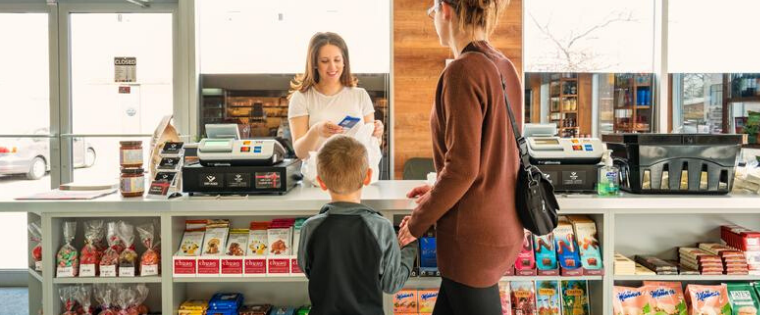Pandemic Poses Challenge for Impulse Purchases

Is the impulse purchase a casualty of the new COVID-molded shopping experience? And what do the suppliers and retailers who rely on checkout lines and other high-traffic areas of a store to help move their low-ticket items such as blind-bag collectibles do to generate sales?
For one thing, it’s difficult to replicate on a website the in-store urge to drop an inexpensive little something into your shopping cart as you wait on the checkout line, particularly absent the nag factor responsible for countless sales of kid-directed small toys, trading cards, candy and such.
Secondly, even if somebody’s shopping in a store, he or she is likely doing it solo, so the whine or tug on a sleeve isn’t there as a “motivator.” And, of course, shoppers in general are making fewer trips to the store, and are taking advantage of services such as curbside pickup.
“You don’t pass by products online”
“If people don’t go to stores and shift online, impulse buying will become less of a factor at retail,” says Gerrick Johnson, an analyst at BMO Capital Markets. “You don’t pass by products online. You don’t have a kid tugging at your shirt yelling, ‘I want that!’ I don’t think they can make that [impulse sales] up. I just think the whole retail representation could be better, offering more opportunity for impulse. Navigating online [for impulse items] can be a horror show.”
Another factor: In many cases, those products have been replaced near the registers by the new essentials — face masks, wipes and hand sanitizers. And while the trend could be short-term during the pandemic, it is unclear how long the shelf shift will continue and what the long-term impact will be.
Displacement
“The checkout lanes are where we do a good part of our business and in the current climate, what is the focus of shopping?” says one licensing executive. “It’s necessities, and I’m not sure impulse items always qualify as that. There are sales going on. But I’m not sure our products are getting upfront placement now versus masks, wipes and Purell.”
Even before the effects of the pandemic were fully felt, the category was showing signs of weakness. For example, sales of toys priced $5 and less fell 18% in the U.S. in the first three month of this year, says Juli Lennett, VP and Industry Advisor for toys at the research firm NPD. Sales of collectibles (which comprise a significant chunk of under-$5 items) declined 13% in the U.S. (and were off 15% in the 13 counties around the world that NPD tracks) during the quarter. Collectibles accounted for 12% of the $27 billion U.S. toy market in 2019 and had a 13% share of the business through March, down from 16% a year earlier, according to NPD.
To cite one specific example, Spin Master last week reported a decline in sales of collectibles (Bakugan, DC Comics, Twisty Pets figures) in Q1 ended March 31.
New Strategies
To combat the downturn in impulse purchase revenues, many companies are sharpening their focus on ecommerce and direct-to-consumer (DTC) businesses, to increase the chance of discovery and to try to drive up the average ticket. Spin Master is developing brand-specific DTC sites, including for Bakugan and Paw Patrol and Friends, the latter launching in June. And Funko is relaunching its web site this summer with an improved recommendation function that will suggest products to be added to the purchase of lower priced items, CEO Brian Mariotti said. Funko’s collectibles sales declined 18.3% to $111.3 million in Q1 ended March 31.
“It is becoming an increasing priority for Funko to continue to build out its e-commerce business, and we are accelerating investments into 2020 to help support this strategy,” said a company spokeswoman.
She adds that the company has always excelled at “its ability to drive traffic at retail and online. As such, we have continued to see durable demand at our mass retail partners during the COVID-19 crisis as consumers continue seek out our products. Also, our 3rd party e-commerce business and our own e-commerce site continues to become an increasing part of our business which shows that consumers are actively looking for our products so they can engage with their favorite properties and fandoms.“
Yet while such ecommerce strategies can replace some of the lost impulse sales, it’s harder to replicate the discovery and surprise of finding a new product in a retail store. And recreating that discovery online can be an expensive endeavor with additional marketing costs sometimes needed to make the consumer aware the product exists, says Lennett.
But that’s not to say companies aren’t trying to recreate the discovery experience digitally. For example, Topps sells digital sports and entertainment trading cards (Garbage Pail Kids, The Walking Dead and others) that seek to replicate the experience of opening a new pack minus the tactile feel. Topps also recently licensed blockchain company Wax to develop technology to help consumers discover, collect, sell and trade cards across Topps properties, which includes another revival of Wacky Package stickers that were first introduced in 1967 and will be launched as collectible figures by licensee Super Impulse in July.
“You do get that experience of seeing a pack unwrapped to reveal the content inside,” says Ira Friedman, VP of Global Licensing at Topps. “So the mystery of not knowing what you are getting before it opens is still there. For some the younger consumers this is the new normal but for some of the older collectors, it isn’t quite the same touchy, feely tactile experience that some people enjoy.”




